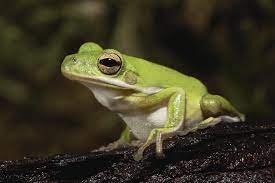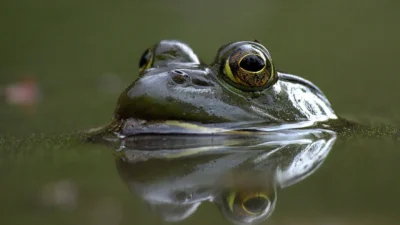Frogs are fascinating creatures, often seen hopping between land and water, but have you ever wondered and ever as the question Can Frogs Breathe Underwater? The answer lies in their unique respiratory system. While frogs are not fish and cannot “breathe” underwater in the same way that aquatic animals do, they possess a remarkable ability to absorb oxygen through their skin.
This process, known as cutaneous respiration, allows frogs to take in oxygen directly from the water, making it possible for them to stay underwater for extended periods. However, this is only part of the story—frogs also have lungs, which they use when on land.
Understanding how frogs breathe both in water and on land reveals the incredible adaptability of these amphibians and their seamless transition between two very different environments.
Understanding Frog Anatomy

Frogs are fascinating creatures with unique anatomical features that make them well-adapted to their environments. Here’s a breakdown of frog anatomy:
External Anatomy
- Skin: Frog skin is thin and permeable, allowing them to absorb water and oxygen directly through it. They have two types of skin glands—mucous glands that keep the skin moist and poison glands that produce toxins for defense.
- Eyes: Frogs have large, bulging eyes that give them a wide field of vision, which is crucial for spotting predators and prey. They also have a third eyelid called the nictitating membrane that protects their eyes underwater.
- Ears: The external ears, or tympanic membranes, are located behind the eyes. These membranes vibrate in response to sound waves, allowing frogs to hear both in air and underwater.
- Legs and Feet: Frogs have strong, muscular hind legs adapted for jumping and swimming. Their feet are often webbed, aiding in swimming. Tree frogs have sticky pads on their toes for climbing.
Internal Anatomy
- Skeletal System: Frogs have a lightweight, flexible skeleton. The backbone (vertebral column) is relatively short, and the pelvis is elongated to support powerful jumping muscles.
- Muscular System: Frogs have well-developed leg muscles that provide the strength needed for leaping and swimming. The muscles are arranged in pairs to allow for coordinated movement.
- Digestive System: Frogs have a simple digestive system that includes the mouth, esophagus, stomach, small intestine, and large intestine. They swallow prey whole, and digestion occurs primarily in the stomach and intestines.
- Respiratory System: Frogs can breathe through their skin, lungs, and the lining of their mouth. This combination allows them to survive both in water and on land.
- Circulatory System: Frogs have a three-chambered heart, consisting of two atria and one ventricle. This setup allows for some mixing of oxygenated and deoxygenated blood, which is sufficient for their metabolic needs.
- Nervous System: The frog’s nervous system includes the brain, spinal cord, and a network of nerves. The brain is relatively simple, with a strong emphasis on sensory input and motor control.
- Reproductive System: Frogs have separate sexes, with males typically being smaller than females. During breeding season, males develop nuptial pads on their thumbs to help grasp females during mating.
- Excretory System: Frogs excrete waste primarily through their kidneys, which filter blood and produce urine. The urine is stored in the bladder until it is expelled.
Adaptations
Frogs are well-adapted to their environments, with features like camouflaged skin, the ability to absorb oxygen through their skin, and powerful legs for jumping. These adaptations allow them to thrive in various habitats, from tropical rainforests to temperate regions.
Understanding frog anatomy helps us appreciate the complexity of these amphibians and their role in ecosystems.
Breathing Mechanisms of Frogs
Frogs have fascinating and versatile breathing mechanisms that allow them to survive in various environments, including water and land. Here’s how frogs breathe:
1. Skin Respiration (Cutaneous Respiration)
Frogs can breathe directly through their skin, which is one of their primary methods of respiration, especially when they are underwater. Their skin is thin, moist, and filled with blood vessels, which allows for the efficient exchange of gases like oxygen and carbon dioxide.
- Process: Oxygen dissolved in water diffuses directly into the blood vessels in the skin, while carbon dioxide diffuses out into the water or air.
- Importance: This method is vital for frogs when they are submerged, as their lungs are not as effective underwater.
2. Lung Respiration
Frogs also have lungs that they use to breathe air, much like humans. However, their lungs are simpler and less efficient than those of mammals.
- Process: Frogs use a unique method called “buccal pumping” to move air into their lungs. Here’s how it works:
- Buccal Cavity Expansion: The frog lowers the floor of its mouth (buccal cavity), causing the cavity to expand. This draws air through the nostrils into the mouth.
- Nostril Closure: The nostrils close, and the floor of the mouth rises, pushing the air into the lungs.
- Exhalation: The frog then contracts its body muscles to expel air from the lungs, which is released through the nostrils or mouth.
- Importance: Lung respiration is crucial when frogs are active on land or need more oxygen, especially during activities like jumping or escaping predators.
3. Mouth Cavity Respiration (Buccopharyngeal Respiration)
Frogs can also exchange gases through the moist lining of their mouth cavity, known as buccopharyngeal respiration.
- Process: While the frog’s mouth is closed, the thin, moist lining of the mouth allows oxygen to diffuse into the bloodstream and carbon dioxide to diffuse out.
- Importance: This method supplements skin and lung respiration, particularly when the frog is at rest and not actively breathing through its lungs.
4. Gills (Tadpole Stage)
During their larval stage (tadpoles), frogs breathe through gills, similar to fish.
- Process: Gills extract oxygen from water and expel carbon dioxide.
- Importance: Gills are essential for the tadpole’s survival in aquatic environments before they develop lungs and transition to breathing air as adults.
Breathing Adaptations
Frogs’ ability to switch between these different breathing mechanisms allows them to thrive in a variety of environments, from ponds and streams to forests and grasslands. Their skin’s ability to absorb oxygen is particularly crucial during hibernation, when frogs often remain submerged in mud or water for extended periods.
Understanding these breathing mechanisms highlights the adaptability and resilience of frogs in diverse habitats.
Do Frogs Breathe Underwater?

Frogs have a unique respiratory system that allows them to breathe both underwater and on land, but they do so in different ways depending on their life stage and environment.
Tadpoles (Frog Larvae):
- When frogs are in their tadpole stage, they are fully aquatic and breathe underwater using gills, much like fish. These gills extract oxygen from the water, allowing the tadpoles to survive and grow until they are ready to transition into adult frogs.
Adult Frogs:
- As they mature into adult frogs, they undergo a metamorphosis during which their gills are replaced by lungs. Adult frogs primarily breathe air using these lungs. However, they still retain the ability to absorb oxygen through their skin, a process known as cutaneous respiration. This is especially useful when frogs are underwater. When submerged, they can stay underwater for extended periods by absorbing oxygen directly from the water through their moist skin.
Breathing on Land:
- On land, frogs breathe air using their lungs, but they continue to rely on cutaneous respiration to supplement their oxygen intake, especially when they are at rest or in a humid environment.
Overall, while adult frogs do not “breathe” underwater in the traditional sense (like fish with gills), they can absorb oxygen through their skin when submerged, allowing them to survive underwater for certain periods.
Factors Affecting Frogs’ Ability to Breathe Underwater
The ability of frogs to breathe underwater is influenced by several factors, primarily related to their biology and environmental conditions. Here are the key factors:
1. Life Stage
- Tadpoles: In the early stage of life, frogs are aquatic and breathe through gills, making them highly efficient at extracting oxygen from water.
- Adult Frogs: After metamorphosis, frogs develop lungs and lose their gills, relying more on cutaneous respiration (through the skin) when underwater.
2. Skin Condition
- Moisture: Frog skin must remain moist for effective cutaneous respiration. If the skin dries out, their ability to absorb oxygen through it decreases significantly.
- Thickness and Permeability: The thickness and permeability of a frog’s skin can vary between species, affecting how well they can absorb oxygen underwater.
3. Water Oxygen Levels
- Oxygen Concentration: The amount of dissolved oxygen in the water directly impacts how efficiently frogs can breathe underwater. Higher oxygen levels make it easier for frogs to absorb the necessary amount.
- Temperature: Warmer water holds less dissolved oxygen, which can make it harder for frogs to breathe underwater, especially in stagnant or polluted environments.
4. Activity Level
- Resting vs. Active: When frogs are resting, their metabolic rate is lower, and they require less oxygen, making cutaneous respiration more sufficient. However, during active periods, they may need to surface to breathe through their lungs more frequently.
5. Species Adaptation
- Aquatic vs. Terrestrial Species: Some frog species are more adapted to aquatic environments and can stay underwater for longer periods. These species often have more efficient cutaneous respiration and can extract more oxygen from the water compared to more terrestrial species.
- Habitat: Frogs that live in oxygen-rich aquatic environments are better suited for underwater respiration compared to those that live in drier or less oxygenated habitats.
6. Water Quality
- Pollution: Contaminants in the water can affect a frog’s skin, reducing its ability to absorb oxygen. Pollution can also decrease the overall oxygen levels in the water, further impacting their ability to breathe.
- pH Levels: Extreme pH levels in water can harm a frog’s skin, potentially reducing its efficiency in cutaneous respiration.
7. Temperature
- Cold vs. Warm Water: Frogs are ectothermic, meaning their body temperature is regulated by the environment. In cold water, their metabolism slows, reducing their oxygen needs, and making cutaneous respiration more effective. In contrast, warmer water increases their metabolism, which can increase their need for oxygen.
Understanding these factors is crucial for the conservation of frog populations, especially in environments where water quality and temperature are changing due to human activities.
How Long Can Frogs Stay Underwater?
Frogs can vary significantly in how long they can stay underwater, depending on their species and their environment. Here’s a general breakdown:
- Aquatic Frogs: Frogs like the African Clawed Frog can stay underwater for extended periods—often hours to even days—because they are well-adapted to an aquatic lifestyle.
- Semi-Aquatic Frogs: Frogs such as the Leopard Frog, which spend time both in water and on land, usually stay submerged for shorter periods, generally ranging from a few minutes to an hour.
- Terrestrial Frogs: Frogs that are mostly terrestrial, like the American Toad, typically do not stay underwater for long. They may only be submerged for a few minutes to escape predators or during breeding.
Frogs have the ability to breathe through their skin (cutaneous respiration), which allows them to stay underwater longer than many other animals. However, they do need to come to the surface occasionally to breathe air, especially if they are not fully aquatic.
Conclusion
Can frogs breathe underwater? While frogs can spend considerable time underwater, they cannot breathe underwater like fish. Instead, they rely on their ability to absorb oxygen through their skin—a process known as cutaneous respiration.
This unique adaptation allows them to stay submerged for varying lengths of time depending on their species and environmental conditions. So, while frogs are well-equipped to handle life both in and out of the water, they still need to surface periodically to breathe air.

